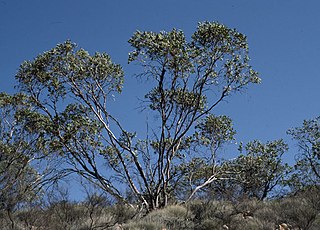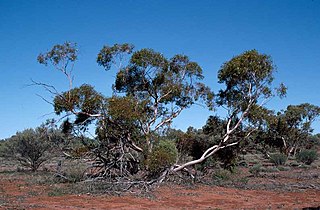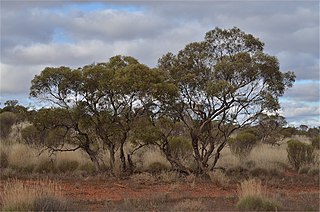
Eucalyptus elata, commonly known as the river peppermint or river white gum, is a species of medium to tall tree that is endemic to eastern Australia. It has rough, compacted bark on the lower trunk, smooth bark above, lance-shaped to curved adult leaves, green to yellow flower buds arranged in groups of eleven to thirty or more, white flowers and hemispherical or shortened spherical fruit.

Eucalyptus smithii, commonly known as the gully gum, gully peppermint, blackbutt peppermint, or ironbark peppermint, is a species of medium-sized to tall tree, sometimes a mallee, that is endemic to southeastern Australia. It has rough, compact bark on the trunk, smooth ribbony bark above, narrow lance-shaped adult leaves, flower buds in groups of seven, white flowers and cup-shaped, bell-shaped or hemispherical fruit.

Eucalyptus nitida, commonly known as the Smithton peppermint, is a species of tree or mallee that is endemic to Tasmania. It has varying amounts of loose, fibrous or flaky bark, lance-shaped to curved adult leaves, flower buds in groups of nine to fifteen, white flowers and cup-shaped to hemispherical fruit.

Eucalyptus dendromorpha, the Budawang ash or giant mallee ash is a species of tree endemic to southeastern Australia. It has rough, compacted bark on the lower part of the trunk, smooth white to cream-coloured bark above, lance-shaped to curved adult leaves, flower buds in groups of between seven and eleven, white flowers and cup-shaped or barrel-shaped fruit.

Eucalyptus serraensis, commonly known as the Grampians stringybark, is a species of small tree or mallee that is endemic to the Grampians in Victoria, Australia. It has rough, stringy, fibrous or flaky bark on the trunk and sometimes also the branches, smooth bark above, lance-shaped to egg-shaped or round adult leaves, sessile flower buds in groups of three or seven, white flowers and hemispherical or cup-shaped fruit.

Eucalyptus fruticosa is a species of mallee that is endemic to Western Australia. It has rough, fibrous or flaky bark on the trunk, sometimes also on the larger branches, smooth pale brownish bark above, linear to narrow elliptical adult leaves, flower buds in groups of between seven and eleven, white to cream-coloured flowers and barrel-shaped to shortened spherical fruit.
Eucalyptus glomerosa, commonly known as jinjulu, is a species of mallee that is endemic to inland Australia. It has rough, fibrous and flaky bark near the base, smooth bark above, egg-shaped to lance-shaped adult leaves, flower buds usually in groups of seven, cream-coloured flowers and conical to hemispherical fruit. It is mainly found in the Great Victoria Desert of South Australia but also grows in eastern parts of Western Australia.

Eucalyptus oxymitra, commonly known as the sharp-capped mallee, is a species of mallee that is endemic to remote parts of Central Australia. It has rough bark on the trunk, smooth greyish bark above, lance-shaped to egg-shaped adult leaves, flower buds in groups of seven, white to pale yellow flowers and hemispherical fruit.

Eucalyptus rugosa, commonly known as the Kingscote mallee, is a species of mallee that is endemic to coastal areas of southern Western Australia and South Australia. It has smooth bark, lance-shaped adult leaves, flower buds in groups of between seven and thirteen, white flowers and cup-shaped, conical or hemispherical fruit.

Eucalyptus trivalva, commonly known as Victoria Spring mallee or desert mallee, is a species of mallee or small tree that is endemic to arid areas of central Australia. It has rough, partly shed bark on some or all of the trunk, smooth bark above, lance-shaped to elliptical adult leaves, flower buds in groups of nine or eleven, white flowers and cup-shaped, cylindrical or conical fruit.

Corymbia chippendalei, commonly known as sand-dune bloodwood or sandhill bloodwood, is a species of small tree or a mallee that is endemic to desert country in central Australia. It has rough bark on part or all of the trunk, lance-shaped adult leaves, flower buds in groups of seven, white flowers and shortened spherical fruit.
Eucalyptus remota, commonly known as the Kangaroo Island ash, Kangaroo Island mallee ash, or Mount Taylor mallee, is a species of tree or mallee that is endemic to Kangaroo Island in South Australia. It has smooth bark, often with rough, fibrous bark on the trunk, lance-shaped adult leaves, flower buds in group of between nine and twenty one, white flowers and hemispherical or shortened spherical fruit.

Eucalyptus concinna, commonly known as the Victoria Desert mallee, is a mallee or small tree that is endemic to Australia. It usually has rough, grey-brown on the lower part of its trunk, smooth bark above, lance-shaped adult leaves, flower buds in groups of between seven and eleven, white flowers and cup-shaped fruit. It has a widespread distribution in South Australia and Western Australia, centred on the Great Victoria Desert.

Eucalyptus ceratocorys, also known as the horn-capped mallee, is a mallee that is native to South Australia and Western Australia. It has rough, ribbony bark at the base of its trunk, smooth greyish bark above, lance-shaped adult leaves, flower buds in groups of seven or nine with ridges along the sides, white to cream-coloured flowers and cylindrical fruit.

Eucalyptus corrugata, also known as rough fruited mallee or rib-fruited mallee, is a species of tree or mallee that is endemic to Western Australia. It has rough scaly or fibrous bark on the lower part of its trunk, smooth bark above, glossy, lance-shaped adult leaves, prominently corrugated flower buds arranged in groups of three in leaf axils and ribbed, conical to cup-shaped fruit.

Eucalyptus cylindrocarpa, commonly known as the woodline mallee, is a species of mallee that is endemic to Western Australia. It has mostly smooth bark, sometimes with loose fibrous or flaky bark near the base of the trunk, linear to lance-shaped or curved adult leaves, flower buds in groups of seven, nine or eleven and cylindrical to barrel-shaped fruit.
Eucalyptus capitanea, commonly known as the desert ridge-fruited mallee, is a species of mallee that is endemic to South Australia. It often has rough, flaky bark on the lower part of the trunk, smooth bark above, lance-shaped adult leaves, ribbed, oval flower buds in groups of seven, cream-coloured flowers and ribbed, urn-shaped fruit.
Eucalyptus molyneuxii is a species of small tree or mallee that is endemic to the Little Desert National Park area of Victoria. It has short-fibrous bark on varying amounts of its trunk and branches, smooth bark above, glossy green, lance-shaped adult leaves, flower buds arranged in groups of between eleven and fifteen, white flowers and cup-shaped or conical fruit.
Eucalyptus silvestris is a species of mallee or small tree that is endemic to Victoria, Australia. It has rough, fibrous or flaky bark on the trunk and larger branches, smooth greyish brown bark above, glossy green, lance-shaped leaves, flower buds usually in groups of seven, white flowers and conical to cup-shaped fruit.

Eucalyptus socialis subsp. socialis, commonly known as the summer red mallee, is a subspecies of mallee that is endemic to inland south-eastern Australia. It usually has rough bark on the base of the trunk, smooth bark above, lance-shaped adult leaves, flower buds in groups of between seven and eleven, pale creamy white flowers and barrel-shaped to urn-shaped or spherical fruit.

















